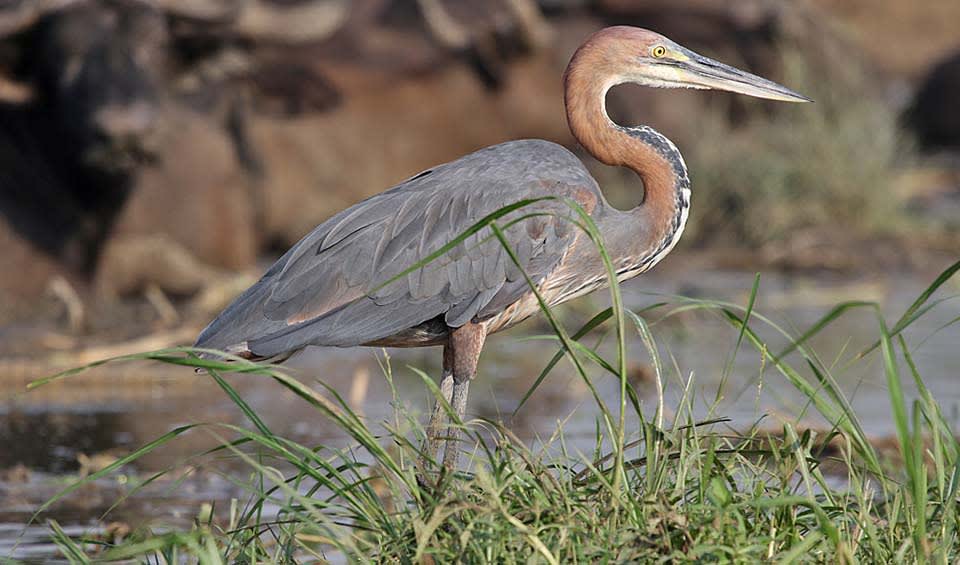Standing as a towering figure among herons, it is indeed the world’s largest heron species. With a statuesque height of up to 1.5 meters (5 feet) and a wingspan that can reach over 2 meters (6.5 feet), it is an imposing presence in the wetlands of sub-Saharan Africa and in smaller, scattered populations throughout Southwest and South Asia.
This magnificent bird is aptly named after the biblical giant Goliath, not only for its size but also for its commanding presence. Its plumage is a striking slate-gray with chestnut-brown underparts, and it sports a distinctive black stripe that extends from its eye to its nape. The Goliath Heron’s long, sinewy neck, when extended, reveals a formidable spear-like bill used with deadly precision in its aquatic hunting grounds.
Specializing in a diet of fish, including sizeable specimens that would be ambitious targets for any other heron, it also consumes amphibians, small mammals, and even baby crocodiles. Its hunting strategy is one of patience; the heron will stand motionless like a statue or wade slowly through shallow waters, waiting for the perfect moment to thrust its bill and snatch up its prey with lightning-fast reflexes.
Despite its size and strength, the Goliath Heron has a rather solitary nature and is often seen alone, except during the breeding season. These birds are territorial when it comes to their feeding grounds, and their slow, deliberate movements are thought to help them blend into the background, reducing disturbance to potential prey.
Distribution
 Angola
Angola Bangladesh
Bangladesh Benin
Benin Botswana
Botswana Burkina Faso
Burkina Faso Burundi
Burundi Cameroon
Cameroon Central Af. Rep.
Central Af. Rep. Chad
Chad Congo-Brazzaville
Congo-Brazzaville Côte D’ivoire
Côte D’ivoire DR Congo (Kinshasa)
DR Congo (Kinshasa) Djibouti
Djibouti Egypt
Egypt Eritrea
Eritrea Eswatini
Eswatini Ethiopia
Ethiopia Gabon
Gabon Gambia
Gambia Ghana
Ghana Guinea-Bissau
Guinea-Bissau Guinea
Guinea India
India Iran
Iran Iraq
Iraq Jordan
Jordan Kenya
Kenya Lesotho
Lesotho Liberia
Liberia Malawi
Malawi Mali
Mali Mauritania
Mauritania Mozambique
Mozambique Myanmar
Myanmar Namibia
Namibia Niger
Niger Nigeria
Nigeria Oman
Oman Pakistan
Pakistan Qatar
Qatar Rwanda
Rwanda Saudi Arabia
Saudi Arabia Senegal
Senegal Sierra Leone
Sierra Leone Somalia
Somalia South Africa
South Africa South Sudan
South Sudan Sri Lanka
Sri Lanka Sudan
Sudan Syria
Syria Tanzania
Tanzania Togo
Togo Uganda
Uganda Yemen
Yemen Zambia
Zambia Zimbabwe
ZimbabweAnything we've missed?
Help us improve this page by suggesting edits. Glory never dies!
Suggest an editGet to know me
Terrestrial / Aquatic
Altricial / Precocial
Polygamous / Monogamous
Dimorphic (size) / Monomorphic
Active: Diurnal / Nocturnal
Social behavior: Solitary / Pack / Herd
Diet: Carnivore / Herbivore / Omnivore / Piscivorous / Insectivore
Migratory: Yes / No
Domesticated: Yes / No
Dangerous: Yes / No




